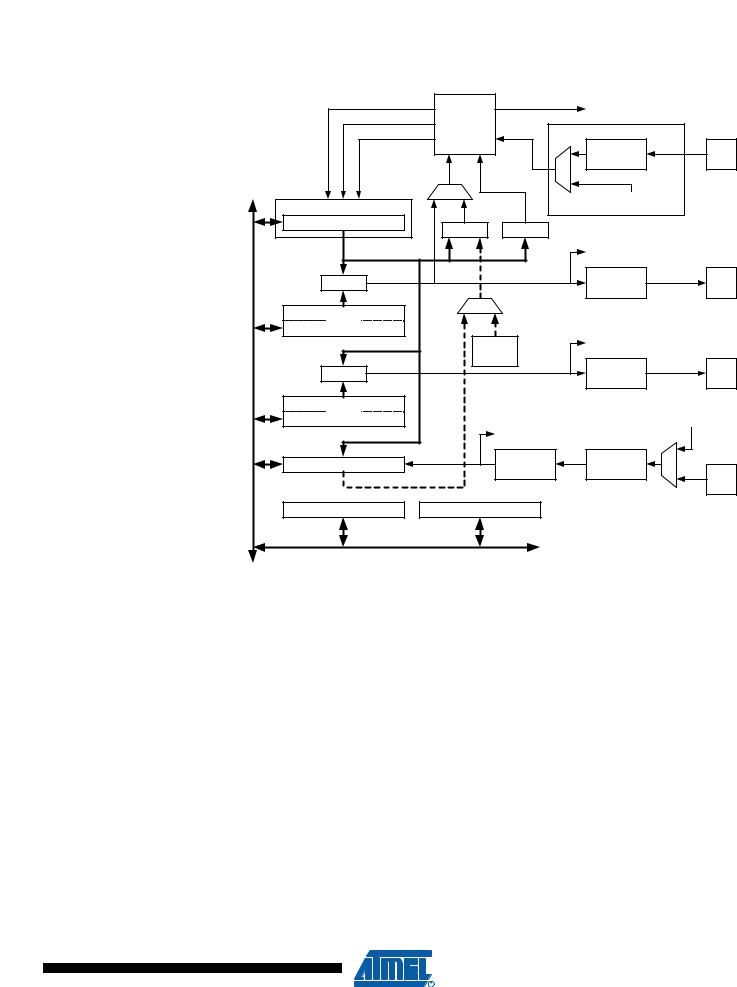
- •Features
- •1. Pin Configurations
- •1.1 Pin Descriptions
- •1.1.3 Port B (PB7:0) XTAL1/XTAL2/TOSC1/TOSC2
- •1.1.4 Port C (PC5:0)
- •1.1.5 PC6/RESET
- •1.1.6 Port D (PD7:0)
- •1.1.8 AREF
- •1.1.9 ADC7:6 (TQFP and QFN/MLF Package Only)
- •2. Overview
- •2.1 Block Diagram
- •2.2 Comparison Between ATmega48PA and ATmega88PA
- •3. Resources
- •4. Data Retention
- •5. About Code Examples
- •6. AVR CPU Core
- •6.1 Overview
- •6.2 ALU – Arithmetic Logic Unit
- •6.3 Status Register
- •6.3.1 SREG – AVR Status Register
- •6.4 General Purpose Register File
- •6.5 Stack Pointer
- •6.5.1 SPH and SPL – Stack Pointer High and Stack Pointer Low Register
- •6.6 Instruction Execution Timing
- •6.7 Reset and Interrupt Handling
- •6.7.1 Interrupt Response Time
- •7. AVR Memories
- •7.1 Overview
- •7.3 SRAM Data Memory
- •7.3.1 Data Memory Access Times
- •7.4 EEPROM Data Memory
- •7.4.1 EEPROM Read/Write Access
- •7.4.2 Preventing EEPROM Corruption
- •7.5 I/O Memory
- •7.5.1 General Purpose I/O Registers
- •7.6 Register Description
- •7.6.1 EEARH and EEARL – The EEPROM Address Register
- •7.6.2 EEDR – The EEPROM Data Register
- •7.6.3 EECR – The EEPROM Control Register
- •7.6.4 GPIOR2 – General Purpose I/O Register 2
- •7.6.5 GPIOR1 – General Purpose I/O Register 1
- •7.6.6 GPIOR0 – General Purpose I/O Register 0
- •8. System Clock and Clock Options
- •8.1 Clock Systems and their Distribution
- •8.2 Clock Sources
- •8.2.1 Default Clock Source
- •8.2.2 Clock Startup Sequence
- •8.3 Low Power Crystal Oscillator
- •8.4 Full Swing Crystal Oscillator
- •8.5 Low Frequency Crystal Oscillator
- •8.6 Calibrated Internal RC Oscillator
- •8.7 128 kHz Internal Oscillator
- •8.8 External Clock
- •8.9 Clock Output Buffer
- •8.10 Timer/Counter Oscillator
- •8.11 System Clock Prescaler
- •8.12 Register Description
- •8.12.1 OSCCAL – Oscillator Calibration Register
- •8.12.2 CLKPR – Clock Prescale Register
- •9. Power Management and Sleep Modes
- •9.1 Sleep Modes
- •9.2 BOD Disable
- •9.3 Idle Mode
- •9.4 ADC Noise Reduction Mode
- •9.7 Standby Mode
- •9.8 Extended Standby Mode
- •9.9 Power Reduction Register
- •9.10 Minimizing Power Consumption
- •9.10.1 Analog to Digital Converter
- •9.10.2 Analog Comparator
- •9.10.4 Internal Voltage Reference
- •9.10.5 Watchdog Timer
- •9.10.6 Port Pins
- •9.11 Register Description
- •9.11.1 SMCR – Sleep Mode Control Register
- •9.11.2 MCUCR – MCU Control Register
- •9.11.3 PRR – Power Reduction Register
- •10. System Control and Reset
- •10.1 Resetting the AVR
- •10.2 Reset Sources
- •10.3 Power-on Reset
- •10.4 External Reset
- •10.6 Watchdog System Reset
- •10.7 Internal Voltage Reference
- •10.8 Watchdog Timer
- •10.8.1 Features
- •10.8.2 Overview
- •10.9 Register Description
- •10.9.1 MCUSR – MCU Status Register
- •10.9.2 WDTCSR – Watchdog Timer Control Register
- •11. Interrupts
- •11.1 Interrupt Vectors in ATmega48PA
- •11.2 Interrupt Vectors in ATmega88PA
- •11.3 Register Description
- •11.3.1 Moving Interrupts Between Application and Boot Space, ATmega88PA
- •11.3.2 MCUCR – MCU Control Register
- •12. External Interrupts
- •12.1 Pin Change Interrupt Timing
- •12.2 Register Description
- •12.2.1 EICRA – External Interrupt Control Register A
- •12.2.2 EIMSK – External Interrupt Mask Register
- •12.2.3 EIFR – External Interrupt Flag Register
- •12.2.4 PCICR – Pin Change Interrupt Control Register
- •12.2.5 PCIFR – Pin Change Interrupt Flag Register
- •12.2.6 PCMSK2 – Pin Change Mask Register 2
- •12.2.7 PCMSK1 – Pin Change Mask Register 1
- •12.2.8 PCMSK0 – Pin Change Mask Register 0
- •13. I/O-Ports
- •13.1 Overview
- •13.2 Ports as General Digital I/O
- •13.2.1 Configuring the Pin
- •13.2.2 Toggling the Pin
- •13.2.3 Switching Between Input and Output
- •13.2.4 Reading the Pin Value
- •13.2.5 Digital Input Enable and Sleep Modes
- •13.2.6 Unconnected Pins
- •13.3 Alternate Port Functions
- •13.3.1 Alternate Functions of Port B
- •13.3.2 Alternate Functions of Port C
- •13.3.3 Alternate Functions of Port D
- •13.4 Register Description
- •13.4.1 MCUCR – MCU Control Register
- •13.4.2 PORTB – The Port B Data Register
- •13.4.3 DDRB – The Port B Data Direction Register
- •13.4.4 PINB – The Port B Input Pins Address
- •13.4.5 PORTC – The Port C Data Register
- •13.4.6 DDRC – The Port C Data Direction Register
- •13.4.7 PINC – The Port C Input Pins Address
- •13.4.8 PORTD – The Port D Data Register
- •13.4.9 DDRD – The Port D Data Direction Register
- •13.4.10 PIND – The Port D Input Pins Address
- •14. 8-bit Timer/Counter0 with PWM
- •14.1 Features
- •14.2 Overview
- •14.2.1 Definitions
- •14.2.2 Registers
- •14.3 Timer/Counter Clock Sources
- •14.4 Counter Unit
- •14.5 Output Compare Unit
- •14.5.1 Force Output Compare
- •14.5.2 Compare Match Blocking by TCNT0 Write
- •14.5.3 Using the Output Compare Unit
- •14.6 Compare Match Output Unit
- •14.6.1 Compare Output Mode and Waveform Generation
- •14.7 Modes of Operation
- •14.7.1 Normal Mode
- •14.7.2 Clear Timer on Compare Match (CTC) Mode
- •14.7.3 Fast PWM Mode
- •14.7.4 Phase Correct PWM Mode
- •14.8 Timer/Counter Timing Diagrams
- •14.9 Register Description
- •14.9.1 TCCR0A – Timer/Counter Control Register A
- •14.9.2 TCCR0B – Timer/Counter Control Register B
- •14.9.3 TCNT0 – Timer/Counter Register
- •14.9.4 OCR0A – Output Compare Register A
- •14.9.5 OCR0B – Output Compare Register B
- •14.9.6 TIMSK0 – Timer/Counter Interrupt Mask Register
- •14.9.7 TIFR0 – Timer/Counter 0 Interrupt Flag Register
- •15. 16-bit Timer/Counter1 with PWM
- •15.1 Features
- •15.2 Overview
- •15.2.1 Registers
- •15.2.2 Definitions
- •15.3.1 Reusing the Temporary High Byte Register
- •15.4 Timer/Counter Clock Sources
- •15.5 Counter Unit
- •15.6 Input Capture Unit
- •15.6.1 Input Capture Trigger Source
- •15.6.2 Noise Canceler
- •15.6.3 Using the Input Capture Unit
- •15.7 Output Compare Units
- •15.7.1 Force Output Compare
- •15.7.2 Compare Match Blocking by TCNT1 Write
- •15.7.3 Using the Output Compare Unit
- •15.8 Compare Match Output Unit
- •15.8.1 Compare Output Mode and Waveform Generation
- •15.9 Modes of Operation
- •15.9.1 Normal Mode
- •15.9.2 Clear Timer on Compare Match (CTC) Mode
- •15.9.3 Fast PWM Mode
- •15.9.4 Phase Correct PWM Mode
- •15.9.5 Phase and Frequency Correct PWM Mode
- •15.10 Timer/Counter Timing Diagrams
- •15.11 Register Description
- •15.11.1 TCCR1A – Timer/Counter1 Control Register A
- •15.11.2 TCCR1B – Timer/Counter1 Control Register B
- •15.11.3 TCCR1C – Timer/Counter1 Control Register C
- •15.11.4 TCNT1H and TCNT1L – Timer/Counter1
- •15.11.5 OCR1AH and OCR1AL – Output Compare Register 1 A
- •15.11.6 OCR1BH and OCR1BL – Output Compare Register 1 B
- •15.11.7 ICR1H and ICR1L – Input Capture Register 1
- •15.11.8 TIMSK1 – Timer/Counter1 Interrupt Mask Register
- •15.11.9 TIFR1 – Timer/Counter1 Interrupt Flag Register
- •16. Timer/Counter0 and Timer/Counter1 Prescalers
- •16.1 Internal Clock Source
- •16.2 Prescaler Reset
- •16.3 External Clock Source
- •16.4 Register Description
- •16.4.1 GTCCR – General Timer/Counter Control Register
- •17. 8-bit Timer/Counter2 with PWM and Asynchronous Operation
- •17.1 Features
- •17.2 Overview
- •17.2.1 Registers
- •17.2.2 Definitions
- •17.3 Timer/Counter Clock Sources
- •17.4 Counter Unit
- •17.5 Output Compare Unit
- •17.5.1 Force Output Compare
- •17.5.2 Compare Match Blocking by TCNT2 Write
- •17.5.3 Using the Output Compare Unit
- •17.6 Compare Match Output Unit
- •17.6.1 Compare Output Mode and Waveform Generation
- •17.7 Modes of Operation
- •17.7.1 Normal Mode
- •17.7.2 Clear Timer on Compare Match (CTC) Mode
- •17.7.3 Fast PWM Mode
- •17.7.4 Phase Correct PWM Mode
- •17.8 Timer/Counter Timing Diagrams
- •17.9 Asynchronous Operation of Timer/Counter2
- •17.10 Timer/Counter Prescaler
- •17.11 Register Description
- •17.11.1 TCCR2A – Timer/Counter Control Register A
- •17.11.2 TCCR2B – Timer/Counter Control Register B
- •17.11.3 TCNT2 – Timer/Counter Register
- •17.11.4 OCR2A – Output Compare Register A
- •17.11.5 OCR2B – Output Compare Register B
- •17.11.6 TIMSK2 – Timer/Counter2 Interrupt Mask Register
- •17.11.7 TIFR2 – Timer/Counter2 Interrupt Flag Register
- •17.11.8 ASSR – Asynchronous Status Register
- •17.11.9 GTCCR – General Timer/Counter Control Register
- •18. SPI – Serial Peripheral Interface
- •18.1 Features
- •18.2 Overview
- •18.3 SS Pin Functionality
- •18.3.1 Slave Mode
- •18.3.2 Master Mode
- •18.4 Data Modes
- •18.5 Register Description
- •18.5.1 SPCR – SPI Control Register
- •18.5.2 SPSR – SPI Status Register
- •18.5.3 SPDR – SPI Data Register
- •19. USART0
- •19.1 Features
- •19.2 Overview
- •19.3 Clock Generation
- •19.3.1 Internal Clock Generation – The Baud Rate Generator
- •19.3.2 Double Speed Operation (U2Xn)
- •19.3.3 External Clock
- •19.3.4 Synchronous Clock Operation
- •19.4 Frame Formats
- •19.4.1 Parity Bit Calculation
- •19.5 USART Initialization
- •19.6 Data Transmission – The USART Transmitter
- •19.6.1 Sending Frames with 5 to 8 Data Bit
- •19.6.2 Sending Frames with 9 Data Bit
- •19.6.3 Transmitter Flags and Interrupts
- •19.6.4 Parity Generator
- •19.6.5 Disabling the Transmitter
- •19.7 Data Reception – The USART Receiver
- •19.7.1 Receiving Frames with 5 to 8 Data Bits
- •19.7.2 Receiving Frames with 9 Data Bits
- •19.7.3 Receive Compete Flag and Interrupt
- •19.7.4 Receiver Error Flags
- •19.7.5 Parity Checker
- •19.7.6 Disabling the Receiver
- •19.7.7 Flushing the Receive Buffer
- •19.8 Asynchronous Data Reception
- •19.8.1 Asynchronous Clock Recovery
- •19.8.2 Asynchronous Data Recovery
- •19.8.3 Asynchronous Operational Range
- •19.9.1 Using MPCMn
- •19.10 Register Description
- •19.10.1 UDRn – USART I/O Data Register n
- •19.10.2 UCSRnA – USART Control and Status Register n A
- •19.10.3 UCSRnB – USART Control and Status Register n B
- •19.10.4 UCSRnC – USART Control and Status Register n C
- •19.10.5 UBRRnL and UBRRnH – USART Baud Rate Registers
- •19.11 Examples of Baud Rate Setting
- •20. USART in SPI Mode
- •20.1 Features
- •20.2 Overview
- •20.3 Clock Generation
- •20.4 SPI Data Modes and Timing
- •20.5 Frame Formats
- •20.5.1 USART MSPIM Initialization
- •20.6 Data Transfer
- •20.6.1 Transmitter and Receiver Flags and Interrupts
- •20.6.2 Disabling the Transmitter or Receiver
- •20.7 AVR USART MSPIM vs. AVR SPI
- •20.8 Register Description
- •20.8.1 UDRn – USART MSPIM I/O Data Register
- •20.8.2 UCSRnA – USART MSPIM Control and Status Register n A
- •20.8.3 UCSRnB – USART MSPIM Control and Status Register n B
- •20.8.4 UCSRnC – USART MSPIM Control and Status Register n C
- •20.8.5 USART MSPIM Baud Rate Registers - UBRRnL and UBRRnH
- •21. 2-wire Serial Interface
- •21.1 Features
- •21.2.1 TWI Terminology
- •21.2.2 Electrical Interconnection
- •21.3 Data Transfer and Frame Format
- •21.3.1 Transferring Bits
- •21.3.2 START and STOP Conditions
- •21.3.3 Address Packet Format
- •21.3.4 Data Packet Format
- •21.3.5 Combining Address and Data Packets into a Transmission
- •21.5 Overview of the TWI Module
- •21.5.1 SCL and SDA Pins
- •21.5.2 Bit Rate Generator Unit
- •21.5.3 Bus Interface Unit
- •21.5.4 Address Match Unit
- •21.5.5 Control Unit
- •21.6 Using the TWI
- •21.7 Transmission Modes
- •21.7.1 Master Transmitter Mode
- •21.7.2 Master Receiver Mode
- •21.7.3 Slave Receiver Mode
- •21.7.4 Slave Transmitter Mode
- •21.7.5 Miscellaneous States
- •21.7.6 Combining Several TWI Modes
- •21.9 Register Description
- •21.9.1 TWBR – TWI Bit Rate Register
- •21.9.2 TWCR – TWI Control Register
- •21.9.3 TWSR – TWI Status Register
- •21.9.4 TWDR – TWI Data Register
- •21.9.5 TWAR – TWI (Slave) Address Register
- •21.9.6 TWAMR – TWI (Slave) Address Mask Register
- •22. Analog Comparator
- •22.1 Overview
- •22.2 Analog Comparator Multiplexed Input
- •22.3 Register Description
- •22.3.1 ADCSRB – ADC Control and Status Register B
- •22.3.2 ACSR – Analog Comparator Control and Status Register
- •22.3.3 DIDR1 – Digital Input Disable Register 1
- •23. Analog-to-Digital Converter
- •23.1 Features
- •23.2 Overview
- •23.3 Starting a Conversion
- •23.4 Prescaling and Conversion Timing
- •23.5 Changing Channel or Reference Selection
- •23.5.1 ADC Input Channels
- •23.5.2 ADC Voltage Reference
- •23.6 ADC Noise Canceler
- •23.6.1 Analog Input Circuitry
- •23.6.2 Analog Noise Canceling Techniques
- •23.6.3 ADC Accuracy Definitions
- •23.7 ADC Conversion Result
- •23.8 Temperature Measurement
- •23.9 Register Description
- •23.9.1 ADMUX – ADC Multiplexer Selection Register
- •23.9.2 ADCSRA – ADC Control and Status Register A
- •23.9.3 ADCL and ADCH – The ADC Data Register
- •23.9.3.1 ADLAR = 0
- •23.9.3.2 ADLAR = 1
- •23.9.4 ADCSRB – ADC Control and Status Register B
- •23.9.5 DIDR0 – Digital Input Disable Register 0
- •24. debugWIRE On-chip Debug System
- •24.1 Features
- •24.2 Overview
- •24.3 Physical Interface
- •24.4 Software Break Points
- •24.5 Limitations of debugWIRE
- •24.6 Register Description
- •24.6.1 DWDR – debugWire Data Register
- •25. Self-Programming the Flash, ATmega48PA
- •25.1 Overview
- •25.1.1 Performing Page Erase by SPM
- •25.1.2 Filling the Temporary Buffer (Page Loading)
- •25.1.3 Performing a Page Write
- •25.2.1 EEPROM Write Prevents Writing to SPMCSR
- •25.2.2 Reading the Fuse and Lock Bits from Software
- •25.2.3 Preventing Flash Corruption
- •25.2.4 Programming Time for Flash when Using SPM
- •25.2.5 Simple Assembly Code Example for a Boot Loader
- •25.3 Register Description’
- •25.3.1 SPMCSR – Store Program Memory Control and Status Register
- •26.1 Features
- •26.2 Overview
- •26.3 Application and Boot Loader Flash Sections
- •26.3.1 Application Section
- •26.3.2 BLS – Boot Loader Section
- •26.5 Boot Loader Lock Bits
- •26.6 Entering the Boot Loader Program
- •26.8.1 Performing Page Erase by SPM
- •26.8.2 Filling the Temporary Buffer (Page Loading)
- •26.8.3 Performing a Page Write
- •26.8.4 Using the SPM Interrupt
- •26.8.5 Consideration While Updating BLS
- •26.8.7 Setting the Boot Loader Lock Bits by SPM
- •26.8.8 EEPROM Write Prevents Writing to SPMCSR
- •26.8.9 Reading the Fuse and Lock Bits from Software
- •26.8.10 Reading the Signature Row from Software
- •26.8.11 Preventing Flash Corruption
- •26.8.12 Programming Time for Flash when Using SPM
- •26.8.13 Simple Assembly Code Example for a Boot Loader
- •26.8.14 ATmega88PA Boot Loader Parameters
- •26.9 Register Description
- •26.9.1 SPMCSR – Store Program Memory Control and Status Register
- •27. Memory Programming
- •27.1 Program And Data Memory Lock Bits
- •27.2 Fuse Bits
- •27.2.1 Latching of Fuses
- •27.3 Signature Bytes
- •27.4 Calibration Byte
- •27.5 Page Size
- •27.6 Parallel Programming Parameters, Pin Mapping, and Commands
- •27.6.1 Signal Names
- •27.7 Parallel Programming
- •27.7.1 Enter Programming Mode
- •27.7.2 Considerations for Efficient Programming
- •27.7.3 Chip Erase
- •27.7.4 Programming the Flash
- •27.7.5 Programming the EEPROM
- •27.7.6 Reading the Flash
- •27.7.7 Reading the EEPROM
- •27.7.8 Programming the Fuse Low Bits
- •27.7.9 Programming the Fuse High Bits
- •27.7.10 Programming the Extended Fuse Bits
- •27.7.11 Programming the Lock Bits
- •27.7.12 Reading the Fuse and Lock Bits
- •27.7.13 Reading the Signature Bytes
- •27.7.14 Reading the Calibration Byte
- •27.7.15 Parallel Programming Characteristics
- •27.8 Serial Downloading
- •27.8.1 Serial Programming Pin Mapping
- •27.8.2 Serial Programming Algorithm
- •27.8.3 Serial Programming Instruction set
- •27.8.4 SPI Serial Programming Characteristics
- •28. Electrical Characteristics
- •28.1 Absolute Maximum Ratings*
- •28.2 DC Characteristics
- •28.2.1 ATmega48PA DC Characteristics
- •28.2.2 ATmega88PA DC Characteristics
- •28.3 Speed Grades
- •28.4 Clock Characteristics
- •28.4.1 Calibrated Internal RC Oscillator Accuracy
- •28.4.2 External Clock Drive Waveforms
- •28.4.3 External Clock Drive
- •28.5 System and Reset Characteristics
- •28.6 SPI Timing Characteristics
- •28.8 ADC Characteristics
- •28.9 Parallel Programming Characteristics
- •29. Typical Characteristics
- •29.1 ATmega48PA
- •29.1.1 Active Supply Current
- •29.1.2 Idle Supply Current
- •Example
- •29.1.6 Standby Supply Current
- •29.1.8 Pin Driver Strength
- •29.1.9 Pin Threshold and Hysteresis
- •29.1.10 BOD Threshold
- •29.1.11 Internal Oscilllator Speed
- •29.1.12 Current Consumption of Peripheral Units
- •29.1.13 Current Consumption in Reset and Reset Pulsewidth
- •29.2 ATmega88PA
- •29.2.1 Active Supply Current
- •29.2.2 Idle Supply Current
- •Example
- •29.2.6 Standby Supply Current
- •29.2.8 Pin Driver Strength
- •29.2.9 Pin Threshold and Hysteresis
- •29.2.10 BOD Threshold
- •29.2.11 Internal Oscilllator Speed
- •29.2.12 Current Consumption of Peripheral Units
- •29.2.13 Current Consumption in Reset and Reset Pulsewidth
- •30. Register Summary
- •31. Instruction Set Summary
- •32. Ordering Information
- •32.1 ATmega48PA
- •32.2 ATmega88PA
- •33. Packaging Information
- •34. Errata
- •34.1 Errata ATmega48PA
- •34.2 Errata ATmega88PA
- •35. Datasheet Revision History
- •Table of Contents

 ATmega48PA/88PA
ATmega48PA/88PA
15. 16-bit Timer/Counter1 with PWM
15.1Features
•True 16-bit Design (i.e., Allows 16-bit PWM)
•Two independent Output Compare Units
•Double Buffered Output Compare Registers
•One Input Capture Unit
•Input Capture Noise Canceler
•Clear Timer on Compare Match (Auto Reload)
•Glitch-free, Phase Correct Pulse Width Modulator (PWM)
•Variable PWM Period
•Frequency Generator
•External Event Counter
•Four independent interrupt Sources (TOV1, OCF1A, OCF1B, and ICF1)
15.2Overview
The 16-bit Timer/Counter unit allows accurate program execution timing (event management), wave generation, and signal timing measurement.
Most register and bit references in this section are written in general form. A lower case “n” replaces the Timer/Counter number, and a lower case “x” replaces the Output Compare unit channel. However, when using the register or bit defines in a program, the precise form must be used, i.e., TCNT1 for accessing Timer/Counter1 counter value and so on.
A simplified block diagram of the 16-bit Timer/Counter is shown in Figure 15-1. For the actual placement of I/O pins, refer to ”Pinout ATmega48PA/88PA” on page 2. CPU accessible I/O Registers, including I/O bits and I/O pins, are shown in bold. The device-specific I/O Register and bit locations are listed in the ”Register Description” on page 128.
The PRTIM1 bit in ”PRR – Power Reduction Register” on page 45 must be written to zero to enable Timer/Counter1 module.
107
8161B–AVR–01/09

 ATmega48PA/88PA
ATmega48PA/88PA
Figure 15-1. 16-bit Timer/Counter Block Diagram(1) |
|
|
|||
|
|
Count |
|
TOVn |
|
|
|
Clear |
|
(Int.Req.) |
|
|
|
Control Logic |
Clock Select |
|
|
|
|
Direction |
clkTn |
|
|
|
|
|
|
Edge |
Tn |
|
|
|
|
Detector |
|
|
|
|
|
|
|
|
|
TOP |
BOTTOM |
|
|
|
Timer/Counter |
|
|
( From Prescaler ) |
|
|
|
|
|
|
|
|
TCNTn |
= |
= 0 |
|
|
|
|
|
|
||
|
|
|
|
OCnA |
|
|
|
|
|
(Int.Req.) |
|
|
= |
|
|
Waveform |
OCnA |
|
|
|
Generation |
||
|
|
|
|
|
|
|
OCRnA |
|
|
|
|
|
|
|
Fixed |
OCnB |
|
|
|
|
(Int.Req.) |
|
|
BUS |
|
|
TOP |
|
|
= |
|
|
OCnB |
||
|
Values |
Waveform |
|||
|
|
|
|
||
|
|
|
|
|
|
DATA |
|
|
|
Generation |
|
OCRnB |
|
|
|
( From Analog |
|
|
|
|
|
||
|
|
|
|
|
|
|
|
|
|
|
Comparator Ouput ) |
|
|
|
ICFn (Int.Req.) |
|
|
|
ICRn |
|
Edge |
Noise |
|
|
|
Detector |
Canceler |
|
|
|
|
|
|
||
|
|
|
|
|
ICPn |
|
TCCRnA |
TCCRnB |
|
|
|
Note: 1. Refer to Figure 1-1 on page 2, Table 13-3 on page 76 and Table 13-9 on page 82 for
Timer/Counter1 pin placement and description.
15.2.1Registers
The Timer/Counter (TCNT1), Output Compare Registers (OCR1A/B), and Input Capture Register (ICR1) are all 16-bit registers. Special procedures must be followed when accessing the 16bit registers. These procedures are described in the section ”Accessing 16-bit Registers” on page 109. The Timer/Counter Control Registers (TCCR1A/B) are 8-bit registers and have no CPU access restrictions. Interrupt requests (abbreviated to Int.Req. in the figure) signals are all visible in the Timer Interrupt Flag Register (TIFR1). All interrupts are individually masked with the Timer Interrupt Mask Register (TIMSK1). TIFR1 and TIMSK1 are not shown in the figure.
The Timer/Counter can be clocked internally, via the prescaler, or by an external clock source on the T1 pin. The Clock Select logic block controls which clock source and edge the Timer/Counter uses to increment (or decrement) its value. The Timer/Counter is inactive when no clock source is selected. The output from the Clock Select logic is referred to as the timer clock (clkT1).
The double buffered Output Compare Registers (OCR1A/B) are compared with the Timer/Counter value at all time. The result of the compare can be used by the Waveform Generator to generate a PWM or variable frequency output on the Output Compare pin (OC1A/B). See ”Out-
108
8161B–AVR–01/09

 ATmega48PA/88PA
ATmega48PA/88PA
put Compare Units” on page 116. The compare match event will also set the Compare Match Flag (OCF1A/B) which can be used to generate an Output Compare interrupt request.
The Input Capture Register can capture the Timer/Counter value at a given external (edge triggered) event on either the Input Capture pin (ICP1) or on the Analog Comparator pins (See ”Analog Comparator” on page 241) The Input Capture unit includes a digital filtering unit (Noise Canceler) for reducing the chance of capturing noise spikes.
The TOP value, or maximum Timer/Counter value, can in some modes of operation be defined by either the OCR1A Register, the ICR1 Register, or by a set of fixed values. When using OCR1A as TOP value in a PWM mode, the OCR1A Register can not be used for generating a PWM output. However, the TOP value will in this case be double buffered allowing the TOP value to be changed in run time. If a fixed TOP value is required, the ICR1 Register can be used as an alternative, freeing the OCR1A to be used as PWM output.
15.2.2Definitions
The following definitions are used extensively throughout the section:
BOTTOM
MAX
TOP
The counter reaches the BOTTOM when it becomes 0x0000.
The counter reaches its MAXimum when it becomes 0xFFFF (decimal 65535).
The counter reaches the TOP when it becomes equal to the highest value in the count sequence. The TOP value can be assigned to be one of the fixed values: 0x00FF, 0x01FF, or 0x03FF, or to the value stored in the OCR1A or ICR1 Register. The assignment is dependent of the mode of operation.
15.3Accessing 16-bit Registers
The TCNT1, OCR1A/B, and ICR1 are 16-bit registers that can be accessed by the AVR CPU via the 8-bit data bus. The 16-bit register must be byte accessed using two read or write operations. Each 16-bit timer has a single 8-bit register for temporary storing of the high byte of the 16-bit access. The same temporary register is shared between all 16-bit registers within each 16-bit timer. Accessing the low byte triggers the 16-bit read or write operation. When the low byte of a 16-bit register is written by the CPU, the high byte stored in the temporary register, and the low byte written are both copied into the 16-bit register in the same clock cycle. When the low byte of a 16-bit register is read by the CPU, the high byte of the 16-bit register is copied into the temporary register in the same clock cycle as the low byte is read.
Not all 16-bit accesses uses the temporary register for the high byte. Reading the OCR1A/B 16bit registers does not involve using the temporary register.
To do a 16-bit write, the high byte must be written before the low byte. For a 16-bit read, the low byte must be read before the high byte.
The following code examples show how to access the 16-bit Timer Registers assuming that no interrupts updates the temporary register. The same principle can be used directly for accessing the OCR1A/B and ICR1 Registers. Note that when using “C”, the compiler handles the 16-bit access.
109
8161B–AVR–01/09

ATmega48PA/88PA
Assembly Code Examples(1)
...
; Set TCNT1 to 0x01FF
ldi r17,0x01
ldi r16,0xFF
out TCNT1H,r17
out TCNT1L,r16
; Read TCNT1 into r17:r16 in r16,TCNT1L
in r17,TCNT1H
...
C Code Examples(1)
unsigned int i;
...
/* Set TCNT1 to 0x01FF */ TCNT1 = 0x1FF;
/* Read TCNT1 into i */ i = TCNT1;
...
Note: 1. See ”About Code Examples” on page 7.
For I/O Registers located in extended I/O map, “IN”, “OUT”, “SBIS”, “SBIC”, “CBI”, and “SBI” instructions must be replaced with instructions that allow access to extended I/O. Typically “LDS” and “STS” combined with “SBRS”, “SBRC”, “SBR”, and “CBR”.
The assembly code example returns the TCNT1 value in the r17:r16 register pair.
It is important to notice that accessing 16-bit registers are atomic operations. If an interrupt occurs between the two instructions accessing the 16-bit register, and the interrupt code updates the temporary register by accessing the same or any other of the 16-bit Timer Registers, then the result of the access outside the interrupt will be corrupted. Therefore, when both the main code and the interrupt code update the temporary register, the main code must disable the interrupts during the 16-bit access.
The following code examples show how to do an atomic read of the TCNT1 Register contents. Reading any of the OCR1A/B or ICR1 Registers can be done by using the same principle.
110
8161B–AVR–01/09

ATmega48PA/88PA
Assembly Code Example(1)
TIM16_ReadTCNT1:
; Save global interrupt flag
in r18,SREG
; Disable interrupts
cli
; Read TCNT1 into r17:r16
in r16,TCNT1L
in r17,TCNT1H
; Restore global interrupt flag
out SREG,r18
ret
C Code Example(1)
unsigned int TIM16_ReadTCNT1( void )
{
unsigned char sreg; unsigned int i;
/* Save global interrupt flag */ sreg = SREG;
/* Disable interrupts */ _CLI();
/* Read TCNT1 into i */ i = TCNT1;
/* Restore global interrupt flag */ SREG = sreg;
return i;
}
Note: 1. See ”About Code Examples” on page 7.
For I/O Registers located in extended I/O map, “IN”, “OUT”, “SBIS”, “SBIC”, “CBI”, and “SBI” instructions must be replaced with instructions that allow access to extended I/O. Typically “LDS” and “STS” combined with “SBRS”, “SBRC”, “SBR”, and “CBR”.
The assembly code example returns the TCNT1 value in the r17:r16 register pair.
The following code examples show how to do an atomic write of the TCNT1 Register contents. Writing any of the OCR1A/B or ICR1 Registers can be done by using the same principle.
111
8161B–AVR–01/09
